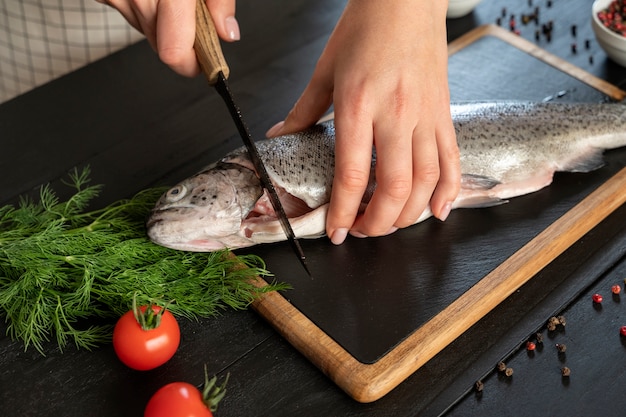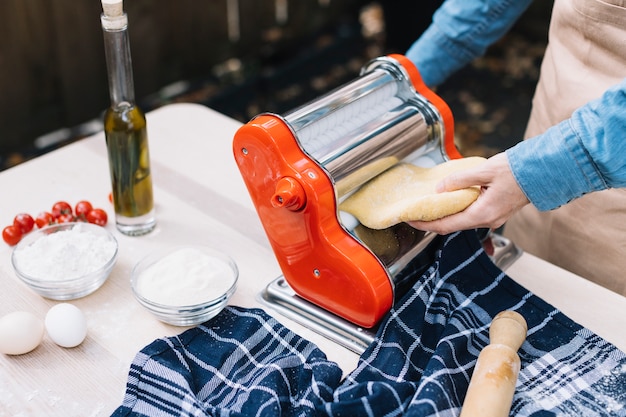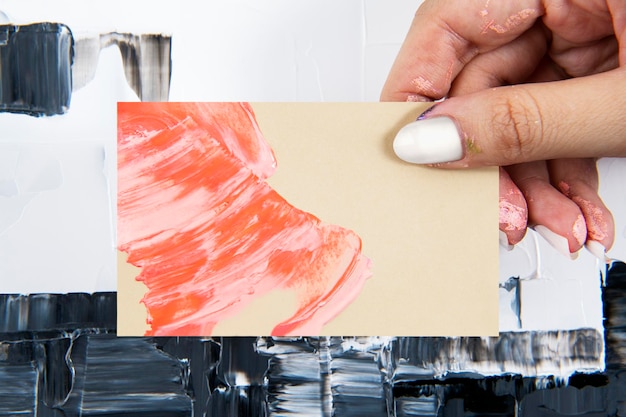You've got a beautiful piece of salmon, gleaming in the fridge, and you're ready to create a delicious meal. But wait! Before you even think about whipping out your pan or firing up the grill, let's talk about the most important thing: temperature. Get this wrong, and your perfectly good salmon can end up dry, tough, and frankly, a bit of a culinary disaster. So, let's dive into the fascinating world of salmon cooking temperatures, a world I've been exploring for years, experimenting with different methods and perfecting my own techniques. Trust me, you'll be thanking yourself later for taking the time to learn this crucial skill.
(Part 1) The Science Behind It All

Before we get into the nitty-gritty of specific cooking methods, let's quickly grasp the basics. Salmon, like most proteins, needs to be cooked to a specific temperature to ensure it's safe to eat. The magic number for salmon is 145°F (63°C) as measured in the thickest part of the fish. This temperature kills any harmful bacteria that might be lurking about, leaving you with a delicious and safe meal. It's like a culinary magic trick, transforming raw salmon into a safe and delightful dish.
But why does it matter?
You might be thinking, "I've cooked salmon before, and it turned out fine." True, but the difference between a perfectly cooked salmon and one that's slightly overdone is HUGE. overcooked salmon will be dry, flaky, and frankly, a bit of a shame. It'll be like eating a piece of cardboard, with little to no flavour. On the other hand, a perfectly cooked salmon will be moist, flaky, and bursting with flavour. It'll melt in your mouth, and you'll be left wanting more. It's a world of difference, I tell you! It's like the difference between a beautifully crafted piece of art and a crude sketch.
(Part 2) The Tools of the Trade

Okay, let's talk tools. You'll need a trusty kitchen thermometer. It's your best friend in the quest for perfect salmon. Don't rely on guesswork or the colour of the fish - use a thermometer to ensure accuracy. I've had my fair share of salmon disasters, and trust me, a thermometer is a lifesaver. I swear by my digital instant-read thermometer, it's quick, accurate, and easy to use. It's like having a little scientist in your kitchen, helping you achieve perfect results.
There are three main types of thermometers:
- Instant-read thermometers: Perfect for checking the internal temperature of your salmon quickly. It's like a little magic wand that tells you instantly if your salmon is ready.
- Oven thermometers: These are used to ensure your oven is heating to the correct temperature. Think of it as a quality control check for your oven, making sure it's operating at the right temperature for perfect cooking.
- Leave-in thermometers: These are inserted into the food and left there to monitor the temperature continuously. It's like having a little guardian angel keeping an eye on your salmon, ensuring it cooks evenly and reaches the perfect temperature.
You can find these thermometers at any good kitchen shop or supermarket. They're a relatively small investment that will pay dividends in delicious salmon dinners. It's a small price to pay for a culinary masterpiece, don't you think?
(Part 3) The Salmon Showdown: Different Cooking Methods

Alright, let's get into the heart of the matter: cooking methods. There are so many ways to cook salmon, each with its own quirks and temperature requirements. From the classic pan-frying to the exciting world of grilling and baking, we'll cover them all. We'll be like culinary explorers, venturing into different techniques and uncovering the secrets to salmon perfection.
3.1 Pan-Frying: A Classic for a Reason
Pan-frying is a quick and easy way to cook salmon, and it delivers a lovely crispy skin. I love this method because it's versatile – perfect for weeknight meals, easy to adapt for different flavour profiles, and you can whip up a delicious sauce in the same pan. It's like a one-pot wonder, with minimal cleanup and maximum flavour. Think of it as a culinary shortcut to deliciousness.
3.2 Baking: Effortless and Delicious
Baking is another excellent option for salmon. It's a hands-off method, perfect for when you're busy with other things. The oven does all the work, leaving you with a beautifully cooked fish. I love baking salmon with a squeeze of lemon and some fresh herbs - so simple, yet so delicious. It's like a culinary hug, with the oven taking care of everything while you relax and enjoy your day.
3.3 Grilling: A Summer Favourite
Grilling is my go-to method for summertime salmon. There's nothing quite like the smoky flavour and the char marks on the fish. It's perfect for backyard barbecues and grilling season. It's like a taste of summer, bringing out the best in salmon with a touch of smokiness and a perfect char.
3.4 Roasting: A Method for Large Portions
Roasting is an excellent option for larger pieces of salmon or when you're cooking for a crowd. It's a simple method that yields juicy and flavorful fish. Think of it as a culinary hero, tackling large portions with ease and delivering a delicious result.
(Part 4) The Temperature Game: A Detailed Guide
Now, let's get specific. I'll break down the ideal temperatures for each cooking method, and provide some tips for perfect results. It's like a culinary road map, guiding you to salmon perfection.
4.1 Pan-Frying:
For pan-frying, aim for a temperature of 350°F (175°C). Heat your pan over medium-high heat for a few minutes, then add a little oil. Pat the salmon dry, season it generously with salt and pepper, and then place it skin-side down in the pan. Cook for 4-6 minutes per side, or until the internal temperature reaches 145°F (63°C). For a perfectly crispy skin, don't move the salmon around too much while cooking. I like to use a fish spatula to gently check for doneness, and lift the fish off the pan to prevent sticking. You'll know your salmon is done when it flakes easily with a fork. Think of it as a culinary dance, a careful balance of heat and time to achieve a perfectly crispy skin and a flaky interior.
4.2 Baking:
For baking, preheat your oven to 375°F (190°C). Place the salmon on a baking sheet lined with parchment paper. You can add a drizzle of olive oil, lemon juice, and herbs, or create a flavourful marinade for a more intense flavour profile. Bake for 15-20 minutes, or until the internal temperature reaches 145°F (63°C). Think of the oven as a gentle and reliable chef, slowly cooking your salmon to perfection.
4.3 Grilling:
When grilling, preheat your grill to medium-high heat. If using a gas grill, aim for a temperature of 400°F (200°C). Clean the grill grates thoroughly before grilling, then place your salmon on the hot grates. Close the lid and grill for 5-7 minutes per side, or until the internal temperature reaches 145°F (63°C). For a nice char, you can also sear the salmon for a few minutes over high heat. I love the charred flavour, it really adds a dimension to the dish. Think of the grill as a culinary artist, adding a smoky flavour and a perfect char to your salmon.
4.4 Roasting:
Preheat your oven to 400°F (200°C). Place the salmon on a baking sheet lined with parchment paper, season generously with salt and pepper, and drizzle with olive oil. Roast for 15-20 minutes, or until the internal temperature reaches 145°F (63°C). It's like a culinary masterpiece, with the oven working its magic to create a juicy and flavorful salmon.
(Part 5) Doneness: The Key to Success
Now, you've got your salmon in the pan, oven, or on the grill, but how do you know when it's done? There are a few tell-tale signs to look out for. First, the salmon should be opaque in colour, no longer translucent. Next, the flesh should flake easily when pressed with a fork. Finally, and most importantly, the internal temperature should reach 145°F (63°C). Think of these indicators as your culinary guide, helping you navigate the journey to salmon perfection.
5.1 The Flake Test
If you're not using a thermometer, the flake test is a good indicator. Gently press the salmon with a fork. If it flakes easily, it's cooked. If it's still a little sticky, it needs more time. It's like a gentle check-up for your salmon, ensuring it's ready for the final stage.
5.2 Colour Change
The colour change from translucent to opaque is another sign of doneness. However, it's not always a foolproof method, especially if you're cooking the salmon in a marinade or sauce. It's a visual clue, but not always a reliable one, so don't rely on it solely.
(Part 6) Resting: A Crucial Step
Once your salmon is cooked to perfection, it's time for a little rest. Let it sit for a few minutes before serving. This allows the juices to redistribute, resulting in a more tender and flavorful fish. Think of this as a culinary pause, a moment to let the flavours settle and the juices to redistribute, creating a truly delightful experience.
(Part 7) Salmon Perfection: A Guide to Serving
Your salmon is cooked to perfection, rested, and ready to be served. But how do you take it to the next level? Here are some tips for serving salmon that will make your taste buds sing.
7.1 Accompaniments:
Salmon pairs beautifully with a variety of accompaniments. I love serving it with roasted vegetables, a simple green salad, or creamy mashed potatoes. It's like a culinary symphony, where the salmon takes centre stage and the accompaniments provide a harmonious backdrop.
7.2 Sauces:
A delicious sauce can elevate your salmon dish. You can go for a classic lemon butter sauce, a creamy dill sauce, or even a spicy sriracha mayo. It's like a culinary flourish, adding a touch of magic and complexity to your salmon creation.
(Part 8) The Salmon Journey: A Personal Touch
You've come a long way in your salmon journey! Now you know the science behind cooking salmon to perfection, and you've got all the tips and tricks for every method. It's time to get creative, experiment, and discover your own favourite way to cook this versatile fish.
I've been cooking salmon for years, and I've learned a lot along the way. But the most important thing is to have fun with it. Don't be afraid to experiment with different ingredients, spices, and sauces. It's all about finding what you like best. Think of it as a culinary adventure, exploring new flavours and finding your own perfect salmon recipe.
So, grab your salmon, fire up the oven, and get cooking! And remember, with the right temperature and a little bit of practice, you'll be making restaurant-quality salmon in no time. It's like unlocking a culinary secret, transforming you from a beginner cook into a salmon maestro.
(Part 9) FAQs:
| Question | Answer |
|---|---|
| What happens if I overcook salmon? | Overcooked salmon will be dry, tough, and lose its delicate flavor. The flesh will also break apart easily. It's like a culinary tragedy, a perfectly good piece of salmon ruined by excessive heat. |
| Can I use a meat thermometer for salmon? | Absolutely! A meat thermometer is perfectly safe to use for salmon. It's a culinary tool that can help you achieve perfect results, ensuring your salmon is cooked to the ideal temperature. |
| How long should I rest my salmon after cooking? | Rest your salmon for 5-10 minutes before serving. This allows the juices to redistribute and ensures a more tender and flavorful fish. It's like giving your salmon a moment to relax and recover, allowing the flavours to meld and the texture to improve. |
| What are some good ways to store leftover salmon? | Refrigerate leftover salmon in an airtight container for up to 3 days. It's like a culinary time capsule, preserving the freshness and flavour of your salmon for future enjoyment. |
| Can I freeze salmon? | Yes, you can freeze salmon. Wrap it tightly in plastic wrap or aluminum foil and freeze for up to 3 months. It's like a culinary magic trick, extending the shelf life of your salmon and ensuring you can enjoy it at a later date. |
Happy cooking, and remember, there's no need to be intimidated by salmon. With a little knowledge and a dash of confidence, you can create delicious and satisfying meals that will impress even the most discerning palate. It's like a culinary journey, filled with discovery, learning, and the joy of creating delicious meals.
Everyone is watching

How to Cook Frozen Lobster Tails Perfectly: A Step-by-Step Guide
RecipesLobster. Just the word conjures up images of lavish meals, special occasions, and a taste of luxury. But let's...

Pigs in a Blanket Cooking Time: How Long to Bake for Perfect Results
RecipesAh, pigs in a blanket. Just the name conjures up images of those delightful little parcels of crispy pastry en...

Pork Fillet Cooking Time: How Long to Cook It Perfectly
RecipesPork fillet, or tenderloin as it's sometimes called, is a real favourite in our house. It's so versatile, and...

The Ultimate Guide to Cooking Delicious Frankfurters
RecipesLet's face it, we all love a good frankfurter. It's a classic, simple, and always satisfying. But let's be rea...

Wolf Meat Recipes: A Guide to Cooking Wild Game
RecipesLet's be honest, you don't see wolf meat at your local butcher shop every day. It's a bit of a wild card, but ...
